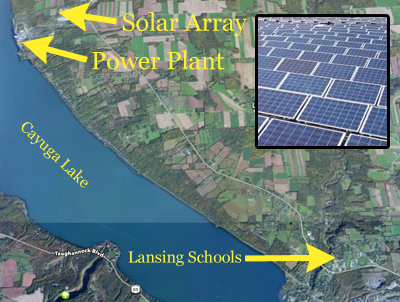- By Dan Veaner
- News
 Print
Print  The Lansing Board Of Education approved a Power Purchase Agreement (PPA) that could mean 68.5% of the school district's electricity will be generated from solar panels. If the project is realized a 1.5 megawatt solar array will be constructed in northwest Lansing, providing substantial savings to the school district over two decades. School District Business Administrator Mary June King says school officials are conservatively projecting a net savings of around $50,000 per year, or at least $1 million over the contract's 20 year life.
The Lansing Board Of Education approved a Power Purchase Agreement (PPA) that could mean 68.5% of the school district's electricity will be generated from solar panels. If the project is realized a 1.5 megawatt solar array will be constructed in northwest Lansing, providing substantial savings to the school district over two decades. School District Business Administrator Mary June King says school officials are conservatively projecting a net savings of around $50,000 per year, or at least $1 million over the contract's 20 year life."This does not mean that we're putting up the array next week," King said. "This means that the agreement can go forward to NYSERDA (New York State Energy Research and Development Authority) and wait for the grant approval. They still have to work on the connectivity at that location, and they do have some backup locations in mind. If that location falls through we don't have to be concerned about anything having to do with where this thing is. We just have to be concerned that you are comfortable with the agreement to purchase power on a long term basis."
The first step Monday was approving the 20 year contract. School attorneys asked the board to approve the agreement subject to further review and revision. King said the substance of the agreement would not likely change, but some of the wording would be adjusted.

If the project is realized a 1.5 MW ground-mounted, inverter-based solar photovoltaics (PV) array will be constructed and maintained by Reading, Pennsylvania company RER PPA, LLC on a plot of land to be leased from Upstate New York Power Producers, Inc. (UNYPP), which operates the Cayuga Power Plant. Power would be transmitted from the site to the school campus just over seven miles southeast of the array.
The array will be made of about 5,000 solar modules that are expected to produce 1,712,542 kWh per year. The district uses approximately 2.5 million killowatt hours of electricity per year.
Almost a year ago the board approved support of an earlier project for a contract that was estimated to save the district $45,000 in energy costs inits first year, and almost $1.4 million over the 20 year life of the contract, providing 95% of the school district's energy from a 18MW solar array. When that project fell through school officials continued to pursue the idea, which led to the new contract.
The agreement requires RER PPA to produce at least 85% of the projected power or to reimburse the school district for the difference between the contracted cost and that of buying the electricity from NYSEG.
King noted that approving the contract is just a step toward making the project a reality. Several other steps are required if the project is to be realized. The biggest hurdle is to get funding. According to King, NYSERDA calls for grant proposals until the amount they have to award is filled in the first round. Any remaining funds are awarded in a second round, but the amount available is likely to be less.
Board Of Education President Glenn Swanson noted that there was a 'little bit of urgency' because getting into the first round of NYSERDA grants will give the district a better chance of obtaining the funding it needs to go forward with the contract.
Swanson recommended the board proceed with the vote with the understanding that minor changes to language, especially that defining penalties for pulling out of the project, would be applied. He noted that if the attorneys end up making major changes the board can meet again to approve a new draft. King said the first wave of grants opened May 4th, but is still open.
Even if a grant is awarded the project will still need to complete geotechnical and Phase I environmental analyses, completion of contract negotiations with UNYPP on the interconnection, approval of the contract by both the school board and RER PPA's financial partners, and completion of an environmental review.
King noted that the school district's only concern is who it buys electricity from. RER PPA will own the equipment and be responsible for delivering the power. However the district will have the opportunity to purchase and operate the system at specified intervals throughout the 20 year life of the contract.
Board members Julie Boles said that approving the contract Monday would allow it to be submitted to NYSERDA for funding. Board Vice president Christine Iacobucci asked for assurances that the board could withdraw its support if it does not agree with changes to the contract.
The board approved the agreement 6-0.
v11i23



